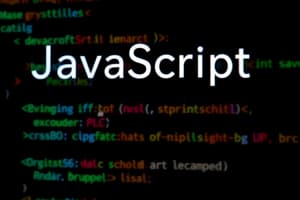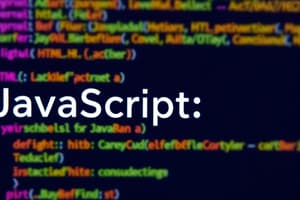Podcast
Questions and Answers
The HTML DOM allows JavaScript to interact with and manipulate the structure and content of web pages.
The HTML DOM allows JavaScript to interact with and manipulate the structure and content of web pages.
True (A)
In the DOM, elements are not considered nodes.
In the DOM, elements are not considered nodes.
False (B)
Which method is used to select an element by its ID?
Which method is used to select an element by its ID?
- querySelector('selector')
- document.getElementByName('name')
- getElementsByClassName('class')
- document.getElementById('id') (correct)
addEventListener() method overwrites existing event handlers.
addEventListener() method overwrites existing event handlers.
What does the click event do?
What does the click event do?
JSON files are heavy and hard to read.
JSON files are heavy and hard to read.
What characters are used to create JSON objects?
What characters are used to create JSON objects?
What method is used to convert a JavaScript object to a JSON string?
What method is used to convert a JavaScript object to a JSON string?
The Fetch API is based on callbacks.
The Fetch API is based on callbacks.
PHP scripts are executed on the client-side.
PHP scripts are executed on the client-side.
What is the file extension for PHP files?
What is the file extension for PHP files?
PHP keywords are case-sensitive.
PHP keywords are case-sensitive.
Which function is used to create a constant in PHP?
Which function is used to create a constant in PHP?
Which of the following is NOT a valid JavaScript DOM operation?
Which of the following is NOT a valid JavaScript DOM operation?
Which of the following is a limitation of JSON?
Which of the following is a limitation of JSON?
What does the Fetch API primarily allow you to do?
What does the Fetch API primarily allow you to do?
What happens when Fetch encounters an HTTP error like 404?
What happens when Fetch encounters an HTTP error like 404?
PHP superglobals are only accessible within functions.
PHP superglobals are only accessible within functions.
$_POST variable is used to collect values from HTML forms using the GET method.
$_POST variable is used to collect values from HTML forms using the GET method.
Which function checks if a variable is set and not NULL?
Which function checks if a variable is set and not NULL?
Flashcards
HTML DOM
HTML DOM
Allows JavaScript to interact with and manipulate web page structure and content.
DOM Structure
DOM Structure
The representation of an HTML document organized hierarchically.
JavaScript DOM Change
JavaScript DOM Change
Allows modification of all HTML elements on a webpage.
getElementById()
getElementById()
Selects an element by its unique identifier.
Signup and view all the flashcards
element.style.property
element.style.property
Modifies the visual styling of elements.
Signup and view all the flashcards
document.createElement()
document.createElement()
Dynamically creates new elements in the DOM.
Signup and view all the flashcards
HTML Events
HTML Events
Responds to actions, enabling dynamic behavior.
Signup and view all the flashcards
addEventListener()
addEventListener()
Used to attach event handlers to elements.
Signup and view all the flashcards
addEventListener() first parameter
addEventListener() first parameter
The parameter that specifies what type of action.
Signup and view all the flashcards
addEventListener() second parameter
addEventListener() second parameter
The parameter that specifies a JavaScript function.
Signup and view all the flashcards
document.getElementById Return Type
document.getElementById Return Type
Representation of a single element object.
Signup and view all the flashcards
'click' Event
'click' Event
When the primary mouse button pressed and released.
Signup and view all the flashcards
JSON file
JSON file
Representing simple data structures in JS format.
Signup and view all the flashcards
JSON Usage
JSON Usage
Transmits data between client and server.
Signup and view all the flashcards
Fetch API
Fetch API
A modern JS interface for network requests.
Signup and view all the flashcards
fetch() function
fetch() function
A promise of data.
Signup and view all the flashcards
response.json()
response.json()
To parse API response as JSON.
Signup and view all the flashcards
JSON file Extension
JSON file Extension
Returns the file type.
Signup and view all the flashcards
JSON Stringify
JSON Stringify
Converts JS object to JSON string.
Signup and view all the flashcards
Fetch API
Fetch API
Allows making network requests in javascript.
Signup and view all the flashcardsStudy Notes
HTML DOM and JavaScript Interaction
- The HTML DOM enables JavaScript to interact with and manipulate web page structure and content.
- The DOM represents an HTML document as a tree-like structure.
- In the DOM, elements are considered nodes.
- JavaScript can modify all HTML elements on a page.
- JavaScript's capabilities include adding new HTML elements.
- JavaScript cannot remove existing HTML elements.
- Elements can be selected by their ID using
document.getElementById('id'). - The syntax
element.style.property = valueis used to manipulate elements. - New elements are added dynamically with
document.createElement(). appendChild()does not remove elements.- Events facilitate responses to user interactions.
addEventListener()doesn't overwrite existing event handlers.- Multiple event handlers of the same type can be added to an element.
- The third parameter of
addEventListener()is not mandatory. - HTML events are actions or occurrences that happen to HTML elements.
- JavaScript can react to HTML events.
Selecting HTML Elements
- The correct method to select an HTML element by its ID is
document.getElementById('id'). - DOM stands for Document Object Model.
- Compiling JavaScript code is not a valid JavaScript DOM operation.
document.getElementsByClassName('class')is used to select elements by their class name.- The
addEventListener()method attaches an event handler to a specified element. - Any number of event handlers can be added to one element.
- The first parameter of
addEventListener()specifies the event type, - The second parameter of the
addEventListener()method specifies the function to be called when an event occurs. - The return type of
document.getElementById()is a single element object. - The 'click' event executes when the user clicks on an element.
- The
onmouseoverevent occurs when the user moves the mouse over an HTML element.
JSON (JavaScript Object Notation)
- A JSON file stores simple data structures and objects in JavaScript Object Notation format.
- JSON is primarily for transmitting data between client and server.
- JSON files are not heavy and hard to read.
- JSON cannot natively represent seven types of data.
- JSON objects are not created by square brackets.
- JSON doesn't allow trailing commas after the last entry in an object or array.
- Most programming languages have built-in JSON support.
- In JavaScript,
JSON.stringify()is not used to decode JSON strings. - JSON data cannot include comments.
- JSON does not let you define a schema.
- The Fetch API is a modern JavaScript interface for making network requests.
- The Fetch API is not based on callbacks.
- The
fetch()function returns a Promise. - Fetch rejects the promise for HTTP errors such as 404 or 500.
- Multiple JSON files can be fetched using multiple
fetch()calls and coordinating with Promises. - The file extension
.jsonis used when saving a JSON file. - Function is not a JSON data type.
- Curly braces
{}are used to create JSON objects. JSON.stringify()is used to convert a JavaScript object to a JSON string.JSON.parse()is used to convert a JSON string to a JavaScript object.- A limitation of JSON is its lack of data types.
- The Fetch API primarily enables making network requests.
- The
fetch()function returns a Promise. response.json()is used to parse the response body as JSON.- When Fetch encounters an HTTP error like 404, the promise is resolved.
PHP (Hypertext Preprocessor)
- PHP stands for PHP: Hypertext Preprocessor.
- PHP scripts aren't executed on the client-side.
- PHP files cannot only contain PHP code.
- PHP can create, open, read, write, delete, and close files on the server.
- PHP is not only compatible with Windows servers.
- PHP code is enclosed within
<?phpand?>tags. - PHP keywords are not case-sensitive.
- PHP variable names are case-sensitive.
- The PHP
echostatement does not have a return value. - PHP automatically assigns a data type to a variable.
- PHP supports more than just string and integer data types.
- Constants in PHP cannot be changed during script execution.
- Constants are automatically global across the entire script.
- PHP superglobals are not only accessible within functions.
$_POSTvariable isn't used to collect values from HTML forms using the GET method.- The
if-elsestatement allows code execution based on a condition. - A
forloop continues until a condition is met. - A
do-whileloop executes the code block at least once. Foreachloop is used to iterate over arrays.- PHP functions are declared using the 'function' keyword.
- PHP arrays can store values other than strings.
- Associative arrays do not use integer indices.
- The
array_pushfunction does not remove the last element of an array. array_mergefunction merges two arrays into one.- The
round()function can round a number down to the nearest integer. - The
empty()function checks if a variable is set. - PHP filters are used for validating and sanitizing data.
password_hash()function uses a one-way hashing algorithm.- Object is not a valid PHP data type.
- The file extension for PHP files is
.php. - The
$symbol is used to declare a variable in PHP. echo()function is used to output data to the screen in PHP.echois faster than print.define()function is used to create a constant in PHP.$_POSTsuperglobal variable collects data from HTML forms using the POST method.- The
do-whileloop in PHP executes a block of code at least once. - The
sort()function sorts an array in ascending order. - The
array_push()function adds an element to the end of an array. max()is used to find the function to find the highest value among arguments- The
ceil()function rounds a number up to the nearest integer. isset()function checks if a variable is set and not NULL.- PHP filters' purpose is to validate and sanitize data.
password_hash()function is used to create a password hash.
Studying That Suits You
Use AI to generate personalized quizzes and flashcards to suit your learning preferences.




